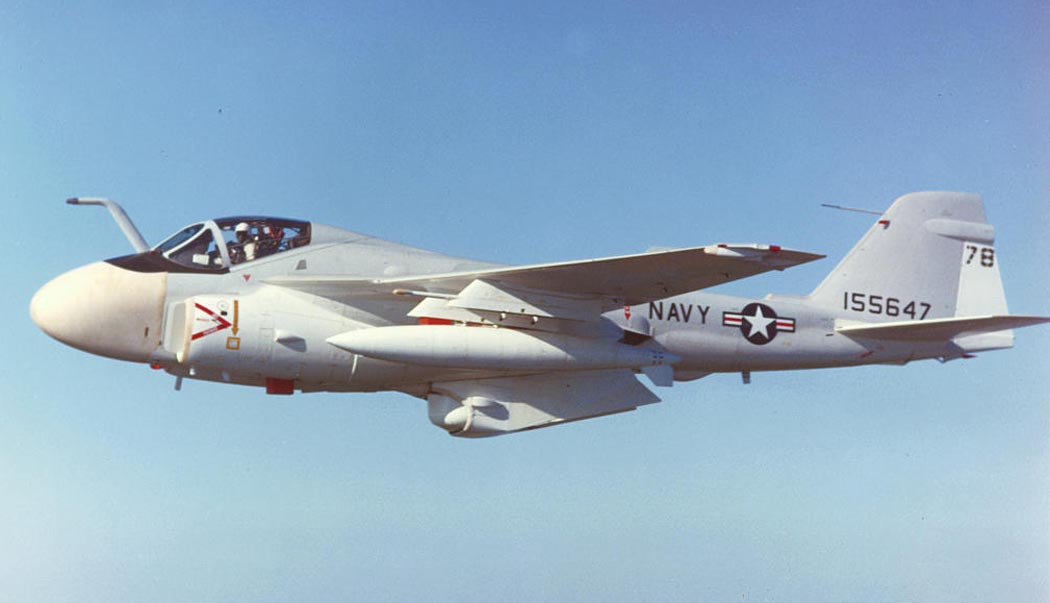Description & History
The A-6C was a variant of the Intruder developed during the Vietnam War in response to an urgent operational need. The US Navy had identified the Ho Chi Minh Trail as a critical logistics route and sought to render it unusable. However, the A-6A’s DIANE (Digital Integrated Attack and Navigation Equipment) system proved inadequate for attacking the trail, which was often hidden beneath dense jungle. DIANE’s radar was optimized for targeting prominent radar-reflective features like ships, bridges, or large infrastructure, not for detecting small, concealed targets such as trucks and supply convoys moving through the jungle wilderness.
To address this limitation, the Navy initiated development of the Trails and Roads Interdiction Multisensor (TRIM) system in 1967. TRIM integrated a suite of electro-optical sensors, including Forward-Looking Infrared (FLIR) and Low-Light-Level Television (LLLTV), housed in a large teardrop-shaped pod mounted on the fuselage centerline station. The cockpit and onboard computers were also modified to accommodate the new TRIM systems.
However, the addition of the centerline pod came at the cost of reduced ordnance capacity, as it eliminated the use of the aft inboard stations (stations 2 and 4). Despite this, the TRIM system significantly improved the Intruder’s ability to detect and engage targets such as vehicles and trains at night or in low-light conditions, though it remained limited in poor weather, such as fog, clouds, or rain.
Initial TRIM testing began in 1967, with the system mounted on modified AP-2B Neptune aircraft operating out of Cam Ranh Bay, South Vietnam, from September 1968 to June 1969. This combat evaluation phase provided valuable feedback to Grumman. One of the first dedicated test platforms was a modified NA-6A (BuNo 147867). Early versions of TRIM used angular wing-mounted pods, but these were replaced with a more refined, removable centerline pod with a rotating turret. Due to the added weight of the system, the A-6C was retrofitted with the stronger tail hook assembly from the EA-6A to accommodate higher landing weights. The first flight of the TRIM-equipped testbed occurred on June 11, 1969.
The modified aircraft were reaccepted into Navy service between February 25 and June 12, 1970, under the new A-6C designation. The first A-6Cs were assigned to VA-165, which received at least eight aircraft by April 1970. Deployed aboard the USS America (CVA-66) that year, VA-165 flew its first A-6C strike in May and logged approximately 675 A-6C combat sorties between May 26 and November 7, 1970. VA-145, operating from the USS Ranger (CVA-61), received five A-6Cs from VA-165 when the Ranger arrived on station in Southeast Asia in November 1970. One A-6C (BuNo 155647) was lost during this period, plunging into the sea after a failed catapult launch on January 8, 1971.
VA-35 also operated the A-6C aboard America from 1972 to 1973. The squadron developed a tactic using the A-6C as a stabilized laser designator platform: after identifying a target via radar or FLIR, the A-6C’s crew would illuminate it with a laser, guiding precision strikes by a second A-6 carrying Texas Instruments Mk 82 Paveway laser-guided bombs.
Several other squadrons, including VA-34 Blue Blasters, VA-75 Sunday Punchers, and VA-176 Thunderbolts, also operated the A-6C while it was in service. The variant remained in frontline use until late 1975. After its retirement, the remaining eleven A-6Cs were upgraded to the latest strike configuration—either at Navy rework facilities or at Grumman’s plant on Long Island. Most A-6Cs were ultimately converted into A-6Es following the end of the Vietnam War.








